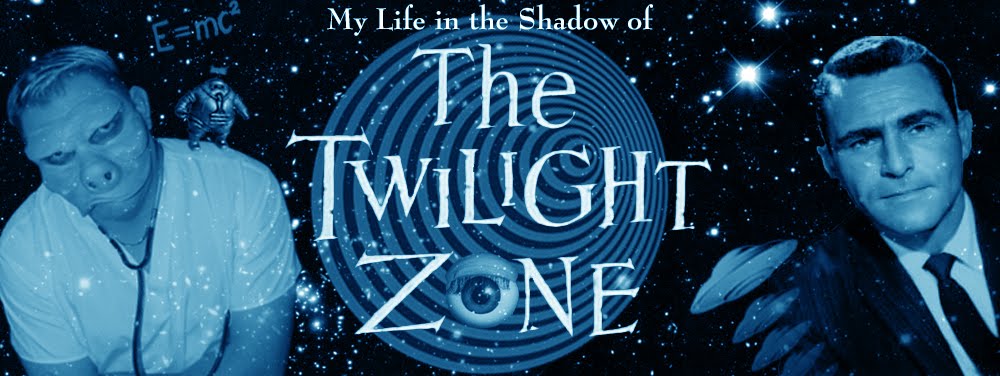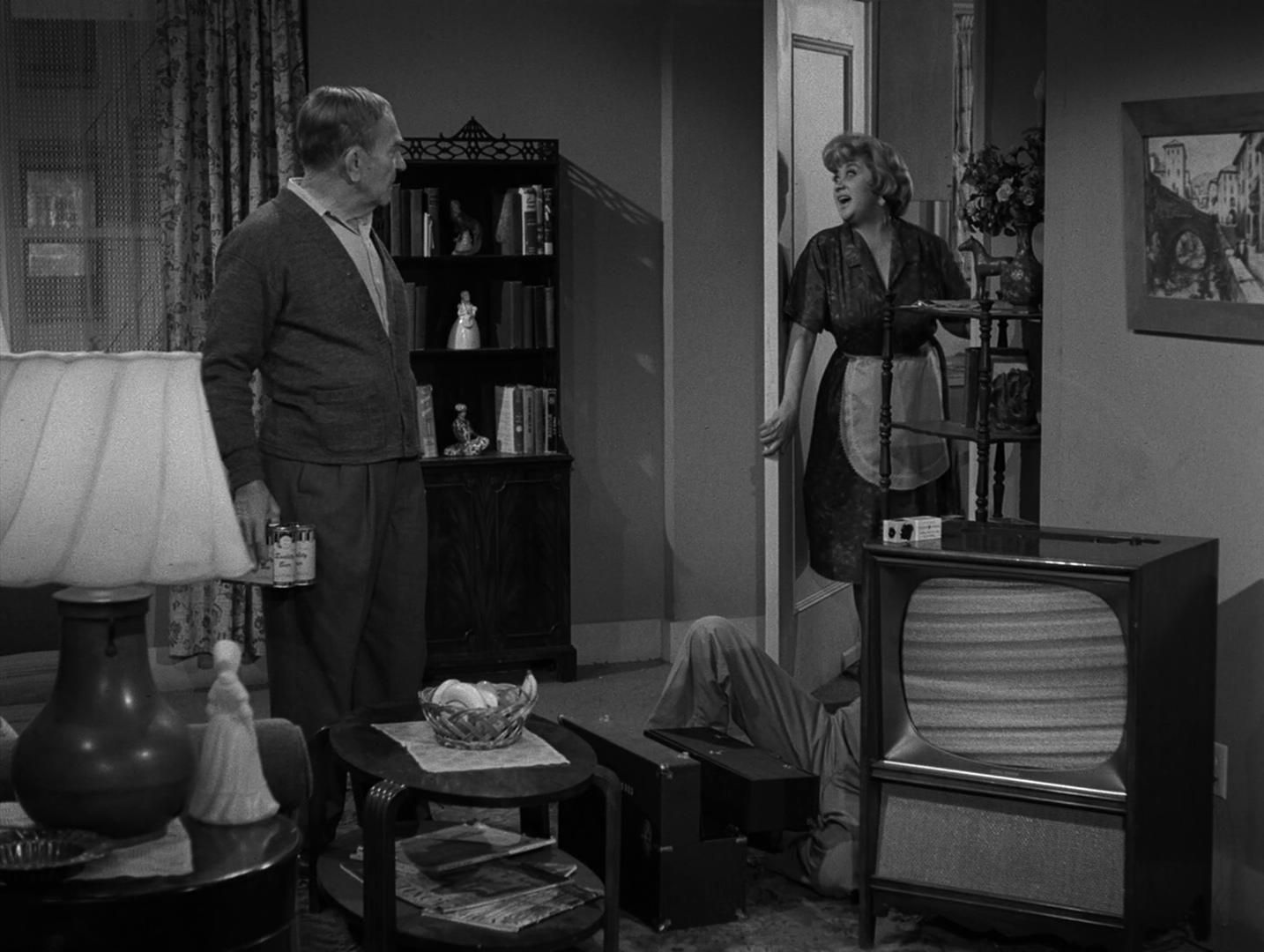Season 5, Episode 26 (146 overall)
Originally aired 3/27/1964
Cayuga Production # 2630
“The man I killed was the white knight. He did what his other pals in this town wanted to but didn’t have the guts. He was the cross burner, the bomb thrower. He handled the whipping of some poor, scared colored guy.”
 That’s Jagger, the town iconoclast, on the morning he is to be hanged. Sheriff Koch, Deputy Pierce, and Colbey (the editor of the local paper) ruminate about Jagger’s precarious conviction, and how all three of them may have skewed the facts to secure it. Odd meteorological detail: the sun hasn’t come up yet in their little town, even though it’s daylight everywhere else.
That’s Jagger, the town iconoclast, on the morning he is to be hanged. Sheriff Koch, Deputy Pierce, and Colbey (the editor of the local paper) ruminate about Jagger’s precarious conviction, and how all three of them may have skewed the facts to secure it. Odd meteorological detail: the sun hasn’t come up yet in their little town, even though it’s daylight everywhere else.At 9:00, the townspeople gather at the gallows, and it’s still dark. Folks are starting to get concerned.
 Jagger is finally brought to the gallows. Offered the opportunity to speak his last words, he vehemently refuses to apologize, incensing the crowd to demand that the hanging commence. Reverend Anderson, the only African American in sight, thanks Jagger for “sticking up for me and mine,” but does have a question: did he enjoy the killing? Jagger acknowledges that he did, satisfying Anderson’s lingering doubts of his guilt. Jagger is hung, at which point the darkness becomes thicker and more impenetrable. Anderson attributes it to the outpouring of hatred he’s witnessed in the Jagger case.
Jagger is finally brought to the gallows. Offered the opportunity to speak his last words, he vehemently refuses to apologize, incensing the crowd to demand that the hanging commence. Reverend Anderson, the only African American in sight, thanks Jagger for “sticking up for me and mine,” but does have a question: did he enjoy the killing? Jagger acknowledges that he did, satisfying Anderson’s lingering doubts of his guilt. Jagger is hung, at which point the darkness becomes thicker and more impenetrable. Anderson attributes it to the outpouring of hatred he’s witnessed in the Jagger case.Back at the station, Colbey turns on the radio. The announcer reports that similar pockets of darkness have appeared all over the world: the Berlin Wall, North Vietnam, Dealey Plaza in Dallas… the list goes on and on.
.
Rod Serling’s script is one of the more obvious examples of his tendency to overwrite dialogue. The characters do express a number of interesting insights, but they’re less impressive when they’re buried under unrealistic verbiage. Still, there are enough powerful moments to carry the piece. It’s an interesting combination of themes addressed previously in season one’s “The Monsters Are Due on Maple Street” (the dangers of mob mentality) and season two’s “Dust” (the questionable morality of the death penalty), both of which were Serling efforts, but “I Am the Night – Color Me Black” never feels like a rehash. In the director’s chair is Abner Biberman, back for his fourth and final TZ stint (he previously directed “The Dummy,” “The Incredible World of Horace Ford” and, more recently, “Number 12 Looks Just like You.” He also directed “The Human Factor” over on ABC’s The Outer Limits as well as four episodes of NBC’s The Fugitive.
This of course isn’t The Twilight Zone’s first hanging. Season one’s “Execution” found an Old West outlaw being strung up, only to vanish in the nick to time (courtesy of a time-tampering scientist from the future). Season two’s “Dust” found a convicted murderer granted an unexpected reprieve when his rope snapped in the nick of time (thanks to a sprinkling of magic dust). But here the hanging occurs without supernatural intervention… it’s as if the third time, as the saying goes, was the charm.*
 The crane shot late in act one as the townspeople gather around the gallows, the clock tower clanging in the distance, is effectively eerie. As they wonder aloud about the inexplicable darkness, it suddenly feels a lot like the aforementioned “The Monsters Are Due on Maple Street,” which featured a similar scene of neighbors discussing their sudden lack of electricity.
The crane shot late in act one as the townspeople gather around the gallows, the clock tower clanging in the distance, is effectively eerie. As they wonder aloud about the inexplicable darkness, it suddenly feels a lot like the aforementioned “The Monsters Are Due on Maple Street,” which featured a similar scene of neighbors discussing their sudden lack of electricity.My favorite moment in the episode comes when Jagger, having incited the crowd to near-riot levels, turns and looks up the gallows. Everything goes completely and immediately silent. His face is framed in the noose, and the reality of the moment is suddenly very evident on his face.
. THE MUSIC
“I Am the Night – Color Me Black” is stock scored, almost exclusively with cues from earlier works by Bernard Herrmann.
The first piece we hear, right at the beginning of the prologue, is Herrmann’s “The Cellar,” which sounds like a selection from his Outer Space Suite, but actually comes from his score for Collector’s Item, an unsold pilot from 1958. The Collector’s Item score was first released on vinyl in 1985 as part of Cerberus Records’ Bernard Herrmann: Music for Radio and Television album, the contents of which were released on CD in 2003 on Prometheus Records’ Bernard Herrmann at CBS, Volume 2: American Gothic.
Next we hear a brief snippet from Herrmann’s radio score for “The Hitch-hiker," which was first released on vinyl in 1983 as part of Cerberus Records’ Bernard Herrmann: The Outer Space Suite album. The suite later appeared on CD in 1999 as part of Silva Screen’s 4-disc Twilight Zone 40th Anniversary Collection.
The bulk of the episode is scored with cuts from Herrmann’s score for “Where Is Everybody?” from season one, a score that has seen three distinct releases. First, it appeared on the second volume of TZ scores from Varese Sarabande (an album which was released on both vinyl and cassette in 1983, then on CD in 1992--- in Japan only). It also appeared on Varese Sarabande’s The Best of The Twilight Zone CD in 1990 and, finally, the aforementioned 4-disc Twilight Zone 40th Anniversary Collection in 1999.
One non-Herrmann cue is heard a few times: “Now We Move” by Nathan Van Cleave, from his score for the “Alice” episode of Have Gun, Will Travel. This score has never been released to my knowledge, and since “I Am the Night – Color Me Black” doesn’t have an isolated music track on the Season 5 DVD and Blu-ray sets, this particular cue is unattainable…. or so a less dedicated blogger might have you believe. If you’re aching to possess Van Cleave’s “Now We Move” cue, it can be found on the isolated music track for “Of Late I Think of Cliffordville” on both the Definitive DVD and Blu-ray releases of Season 4. The cue is heard three different times, so you can’t miss it. So if your heart is set on assembling a complete soundtrack for this episode…. well, now you can. You’re welcome.
DRAMATIS PERSONAE
 Sheriff Charlie Koch is played by Michael Constantine in his only TZ appearance. He'd cross paths with Rod Serling again in the Night Gallery episode "The Boy Who Predicted Earthquakes" but, before that, he popped up on the "Counterweight" episode of The Outer Limits.
Sheriff Charlie Koch is played by Michael Constantine in his only TZ appearance. He'd cross paths with Rod Serling again in the Night Gallery episode "The Boy Who Predicted Earthquakes" but, before that, he popped up on the "Counterweight" episode of The Outer Limits.Rev. Anderson is played with appropriate gravitas by Ivan Dixon, whom we know better as boxer Bolie Jackson from season one's "The Big Tall Wish." Dixon also appeared twice on The Outer Limits ("The Human Factor" and the two-part "The Inheritors"... so maybe we should call that three appearances). He also directed six episodes of The Greatest American Hero, which was my favorite show when I was in the 6th grade (incidentally, I’m strongly considering doing a blog about it at some point).
Colbey, the newspaper editor, is played by Paul Fix, who is probably best remembered by genre fans as Dr. Piper in the "Where No Man Has Gone Before" episode of Star Trek, which is the only regular series episode of the series in which Dr. Leonard "Bones" McCoy does not appear.
If Terry Becker (Jagger) looks familiar to you, it may be that you enjoyed him as Chief Francis Ethelbert Sharkey) on TV's Voyage to the Bottom of the Sea. Ella Koch (the sheriff's wife) is played by Eve McVeagh, who previously appeared in season three's "Kick the Can." She did four stints on Alfred Hitchcock Presents "Coyote Moon," "The Gloating Place," "The Test" and "What Frightened You, Fred?" as well as two Alfred Hitchcock Hours ("Last Seen Wearing Blue Jeans" and "The Second Wife"). George Lindsey (Deputy Pierce) appeared in the memorably disturbing Alfred Hitchcock Hour episode "The Jar" (which co-starred TZ alum Collin Wilcox and was scored by Bernard Herrmann), but let's be honest: he'll always be Goober Pyle (of The Andy Griffith Show fame).
"I Am the Night - Color Me Black" is Serling's final leftist political rant of the series. I'm not knocking leftist politics (I'm pretty liberal myself), but when you get preachy... well, pointing at a racist and yelling "racist!" isn't going to open his/her mind. I totally agree with the sentiment, but.....
Ahem. It's still pretty decent, thanks mostly to powerful performances by Terry Becker and Ivan Dixon. And as you can see from the screen captures, the episode is beautifully dark and noirish. And speaking of going dark.... we now have ten episodes left.
Next week:
You might want to turn a deaf ear to next week's offering. No, seriously.
*Of course we also saw a successful hanging just a few weeks ago in “An Occurrence at Owl Creek Bridge,” but I’m not counting it since it’s technically not a Twilight Zone episode.













.png)

.png)

.JPG)

.jpg)















.png)

+3.JPG)


















.jpg)

.png)






